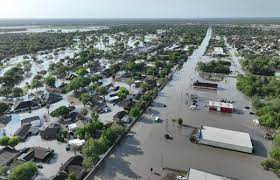Texas Catastrophic Floods Prompt Disaster Declaration and National Emergency Response
Flash floods have devastated central Texas, leading to an official Texas Catastrophic Floods disaster declaration and raising widespread alarm about continued public safety threats and the far-reaching impact on the insurance and reinsurance sector. As of the latest reports, at least 81 lives have been lost, and 41 individuals remain missing in what is now one of the most fatal flood events in recent state history.
Officials caution that the numbers are expected to climb further, as emergency teams work across flood-ravaged counties to recover victims and rescue those still trapped. Entire neighborhoods lie underwater, and worsening weather conditions suggest the crisis is far from over.
Texas Catastrophic Floods Overwhelm Kerr County with Record Rainfall
The Texas Catastrophic Floods struck with alarming speed late Thursday night, extending into Friday morning, unleashing torrential rains that delivered months’ worth of precipitation in mere hours. In one shocking development, the Guadalupe River surged 26 feet in just 45 minutes, breaching embankments and engulfing surrounding infrastructure.
The epicenter of the devastation is Kerr County, where current estimates report the tragic loss of 40 adults and 28 children. Rescue efforts are ongoing, with emergency teams navigating dangerous floodwaters in their search for survivors and access to isolated communities.
With further rainfall in the forecast, rising river levels remain a dire concern, threatening additional lives and further destabilizing already-compromised buildings and public utilities.
Texas Government and FEMA Mobilize in Response to Texas Catastrophic Floods
Recognizing the escalating threat posed by the Texas Catastrophic Floods, Governor Greg Abbott issued an urgent statement warning of continued flash flooding across vast areas of the state. He confirmed that more rain is expected over the coming days and emphasized the readiness of emergency responders to act swiftly.
In parallel, President Donald Trump signed a major disaster declaration for Kerr County on Sunday, triggering the deployment of the Federal Emergency Management Agency (FEMA). The declaration enables the release of federal aid to support local and state recovery efforts, including emergency housing, infrastructure repair, and humanitarian assistance.
“We’re working very closely with representatives from Texas, and it’s a horrible thing that took place, absolutely horrible,” President Trump stated during a briefing from New Jersey.
Texas Catastrophic Floods Spark Concern Across the Reinsurance Sector
While the primary focus remains on life-saving efforts, the economic ramifications of the Texas Catastrophic Floods are already rippling across the insurance and reinsurance industry. Though final loss estimates are premature, analysts agree that the combination of widespread infrastructure damage and high fatalities suggests a potentially significant financial toll.
Texas has historically been a hotspot for natural disasters—including hurricanes, droughts, and floods—and this latest weather event may lead to a wave of claims from homeowners, businesses, and municipalities.
The reinsurance market, still recovering from recent global catastrophes, faces renewed strain. Although the National Flood Insurance Program (NFIP) will absorb some losses, private insurers are expected to incur substantial claims, especially for business interruptions, infrastructure damage, and non-covered flood-related perils.
Texas Catastrophic Floods Intensify Humanitarian and Infrastructure Challenges
Beyond the economic implications, the humanitarian crisis continues to deepen. Emergency evacuation shelters have been set up in Kerr County and nearby communities. Displaced residents are being offered shelter, meals, and medical aid by government agencies and nonprofit organizations.
The infrastructure impact is also severe. Washed-out roads and collapsed bridges have isolated many areas. Power outages and unsafe drinking water affect thousands of households. Schools have closed indefinitely, and hospitals are operating at near-capacity, treating flood-related injuries and illnesses.
Spontaneous rescue groups and non-governmental organizations are working around the clock to support overwhelmed public response teams.
Texas Catastrophic Floods Worsened by Climate-Driven Weather Extremes
Meteorologists warn that the Texas Catastrophic Floods may not be a standalone event. Additional severe thunderstorms and heavy rainfall are expected within days. With the ground already saturated and rivers above flood stage, the region remains highly vulnerable to secondary flooding, landslides, and ongoing property damage.
Climate experts are also weighing in, noting that the increasing frequency and intensity of such extreme weather events are consistent with climate change-driven atmospheric instability. The flood has reignited conversations around the urgent need for revised risk modeling, better urban planning, and stronger infrastructure resiliency strategies.
Conclusion: Texas Catastrophic Floods Demand Long-Term Recovery and Resilience
The Texas Catastrophic Floods have left a trail of devastation—claiming lives, displacing families, and disrupting entire communities. As FEMA and state agencies initiate recovery operations, the focus must also shift toward long-term resilience, both in public policy and within the financial and insurance sectors.
For insurers and reinsurers, the disaster underscores the mounting risk from climate volatility and the necessity of evolving underwriting standards, catastrophe models, and portfolio diversification strategies.
As floodwaters continue to rise and rescue missions persist, Texas faces not just a path to recovery—but a challenge to rebuild stronger, smarter, and more climate-resilient for the future.




